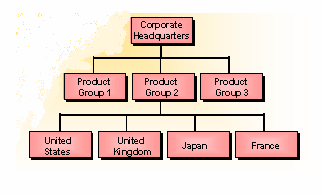Global Division Structure or International Division Structure of an Multinational Enterprise involves vesting the responsibility for total management of global business activities with one designated division or department called Global Division. Globally specialized personnel are placed in charge of the division to handle the diverse matters as export/import negotiations, export/import documentation, foreign-exchange transactions, relations with foreign governments, foreign subsidiaries personnel management, foreign market promotion, etc. Most MNCs in their initial stages of globalization employed the ‘Global Division Structure’ covering certain regions of the world to supervise the functions in those regions. But conflicts could arise between the functional heads and the heads of the global division. Following figure gives a simple model of Global Division Structure. Randall S. Schuler, Peter J. Dowling, Helen De Cieri in their research paper in Journal of Management, Summer, 1993, observed that in the case of the Global division structure (design) the MNE basically adds Continue reading
International Business Basics
What Is International Franchising?
Franchisers sell a defined, proven business format or method of operation, offering a product or service that has sold successfully. An independent business is based on both an untried idea and operation. Franchisees can often buy lower-cost goods and supplies through the franchiser, resulting from the group purchasing power of all the franchises. Franchising provides a uniform system of operation, so that consumers receive uniform quality, efficiently and cost-effectively. A uniform system brings with it the advantages of mass purchasing power, brand identification, and customer loyalty, capitalizing on the proven format. A franchiser also provides management assistance, including accounting procedures, personnel and facility management. An individual with experience in these areas may not be familiar with how to apply them in a new business. The franchiser helps a franchisee overcome this lack of experience. Franchisors help franchisees develop a business plan. Many elements of the plan are standard operating procedures Continue reading
Multinational Corporations (MNCs) – An Overview
Multinational Corporations (MNCs) are businesses that extend outside of their own country, whether they are located throughout the world or only in a couple other countries, they are considered multinational. The value adding activities which are owned by these companies are used to produce tangible goods or intangible services or the combination of both. There are many reasons as to why firms become multinational and there are various strategies for a firm to become multinational. The immediate motives of the Firms can be to expand business, to seek new market, or for additional profits and revenues. It may also be to concentrate on the economics of scale that a larger international demand can bring. The motive behind market seeking activities is strong among firms who have some advantage related to technology or brand which gives them a competitive advantage over domestic rival. Another reason for firms to become multinationals is Continue reading
Transfer Pricing Methods
In a simple terms the term Transfer pricing refers to the prices that related parties charge one another for goods and services passing between them. The most common application of the Transfer pricing rules is the determination of the correct price for sales between subsidiaries of a multinational corporation. These prices can be used to shift profits to tax-favored jurisdictions, If in a transaction between a subsidiary in a high-tax jurisdiction and another in a low-tax jurisdiction, the high-tax subsidiary charges a price below the “true” price, some of the group’s economic profit is shifted to the low-tax subsidiary. Obviously taxpayers would want to engage in this sort of behavior because it can significantly reduce their taxes. If there were no limitations on this behavior, the entire income of multinational corporations would be taxed at the lowest tax rate in the world to zero rate of taxation. Consequently most countries Continue reading
Transfer Pricing – Definition, Objectives and Principles
Meaning and Definition of Transfer Pricing Large organizations are divided into a number of divisions to facilitate managerial control. The problem of transfer pricing arises when one division of the organization transfers its output to another division as an input. A transfer price is the price one segment (sub unit, department, division etc.) of an organization charges for a product or service supplied to another segment of the same organization. The transfer from one segment to another is only an internal transfer and not a sale. Transfer pricing is needed to monitor the flow of goods and services among the divisions of a company and to facilitate divisional performance measurement. The main use of transfer pricing is to measure the notional sales of one division to another division. Thus the transfer prices used in the organization will have a significant effect on the performance evaluation of the various divisions. This Continue reading
Why Marketing Strategies of Global Companies Sometimes Fail
‘The world today is a global village’ it’s a fact. But the global village still has some tribes and it is very important to keep all the tribes happy if we need to have good relationship with all of them. Since the globe is accessible to everyone, it is also vital to design the marketing strategy and develop it in the perspective of variations in the culture, traditions, taste, weather and norms of a country. One of the most striking trends in business has been growing internationalization of the business. Companies are going global but they have to keep their customers satisfied domestically and internationally. The internationalization affected the business strategies and the companies are in the rethinking process to counter the problems in the global marketing strategies. Marketing is no exception to this. Attitude of the customers in this regard is very important for designing the marketing strategy, especially Continue reading

